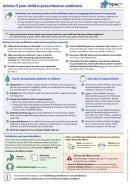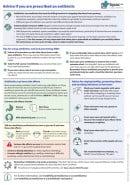Wishing everyone a safe and happy Christmas and New Year – Meri Kirihimete from the Healthify team.
Ornidazole
Sounds like 'or-nye-dah-zole'
Key points about ornidazole
- Ornidazole is an antibiotic used to treat specific types of infections.
- Find out how to take it safely and possible side effects.

Ornidazole is an antibiotic used to treat infections caused by bacteria that don't require oxygen to grow and multiply (called anaerobic infections). Examples of such infections are amoebiasis, giardia, trichomoniasis and bacterial vaginosis.
Ornidazole works by killing or stopping the growth of the bacteria. Like all antibiotics, ornidazole isn't effective against infections caused by viruses.
In Aotearoa New Zealand, ornidazole is available with a prescription from a prescriber.
In Aotearoa New Zealand, ornidazole comes as tablets (500 mg).
- Always take your ornidazole exactly as your healthcare provider has told you. The pharmacy label on your medicine will tell you how much to take, how often to take it, and any special instructions.
- The dose of ornidazole will be different for different people, depending on the type of infection and your age.
- The usual dose for adults is 1 to 3 tablets, taken once as a single dose or 1 to 2 times daily.
- Your healthcare provider will tell you how long to take ornidazole for (usually 1 to 10 days).
- The dose for children will depend on their body weight. It's usually given 1 to 2 times a day.
- Timing: Take ornidazole tablets at about the same time(s) each day.
- Food: Take your ornidazole tablets with or after food. Swallow the tablets with a glass of water. If you take them on an empty stomach, it may cause a sore tummy.
- Missed dose: If you forget to take your dose, take it as soon as you remember. But if it's nearly time for your next dose, just take the next dose at the usual time. Don't take double the dose.
- Finish the course: It's best to take the whole course of antibiotics for the number of days your healthcare provider has told you to. Don't stop taking it, even if you feel your infection has cleared up. Talk to your healthcare provider first.
Here are some things to know when you're taking ornidazole. Other things may be important as well, so ask your healthcare provider what you should know about.
Drinking alcohol
Don't drink alcohol while you're taking ornidazole and for at least 3 days after finishing treatment. Drinking alcohol with ornidazole may make you nauseous (feel sick), vomit (be sick), have stomach cramps, headaches and flushing.
Other things to know:
- Other medicines: Ornidazole interacts with some medicines, herbal supplements and rongoā Māori, so check with your healthcare provider before starting ornidazole and before starting any new products.
- If you’re sick: If you’re sick (vomit) less than 30 minutes after having a dose of ornidazole, take the same dose again. But, if you vomit more than 30 minutes after having a dose of ornidazole, you don’t need to take another dose. Wait until the next usual dose.
- If you're taking the contraceptive pill: You don't usually need to use additional contraception if you're taking ornidazole. But if you have diarrhoea (runny poo/hamuti) or vomiting (being sick) lasting more than 24 hours, absorption of the contraceptive pill may be affected. If this happens, ask your healthcare provider or pharmacist for advice about contraception over the following few days.
- Pregnancy or breastfeeding: Talk to your healthcare provider if you're pregnant, planning a pregnancy or want to breastfeed.
Like all medicines ornidazole can cause side effects, although not everyone gets them. If you're concerned about any symptoms you think might be related to your medicine, talk to your healthcare provider. The following information offers some guidance but doesn't include all possible side effects.
Common side effects
Tell your healthcare provider if these side effects bother you.
- Nausea (feeling sick) or vomiting (being sick): Take ornidazole with food.
- Feeling tired, confused or dizzy: Be careful when driving or using tools until you know how this medicine affects you. Don’t drink alcohol.
- Small white patches in your mouth or a white furry tongue (oral thrush): Ask your healthcare provider for advice.
- Vaginal itching, soreness or discharge (vaginal thrush): Ask your healthcare provider for advice.
Tell your healthcare provider immediately or phone Healthline free on 0800 611 116 if these occur
- Seizures.
- Changes in vision such as blurred vision.
- Signs of problems with your liver such as yellowing of the skin or eyes, dark urine, pain in the tummy.
Phone 111 for an ambulance or go to your nearest accident and emergency (A&E) clinic if these occur
- Signs of an allergic reaction such as itchy skin, and rash, swollen lips or tongue, problems breathing, like a tight chest or shortness of breath.
Read more about medicines and side effects and reporting a reaction you think might be a side effect.
The following links provide further information on ornidazole:
Ornidazole(external link) New Zealand Formulary Patient Information
Arrow-Ornidazole(external link) Medsafe Consumer Medicine Information
Brochures
Advice if your child is prescribed an antibiotic [PDF, 98 KB] BPAC, NZ, 2024
Advice if you are prescribed an antibiotic [PDF, 107 KB] BPAC, NZ, 2024
Medicines and side effects(external link) Healthify He Puna Waiora, NZ, 2024
References
- Ornidazole(external link) New Zealand Formulary
- Ornidazole(external link) New Zealand Formulary for Children
- Antibiotic guide – choices for common infections(external link) BPAC, NZ, 2023
- Arrow-Ornidazole(external link) Medsafe datasheet, NZ
Brochures

Advice if your child is prescribed an antibiotic
BPAC, NZ, 2024

Medicines and side effects
Healthify He Puna Waiora, NZ, 2024
Credits: Healthify editorial team. Healthify is brought to you by Health Navigator Charitable Trust.
Reviewed by: Stephanie Yee, Pharmacist, Auckland.
Last reviewed:






